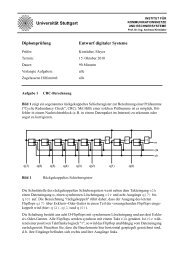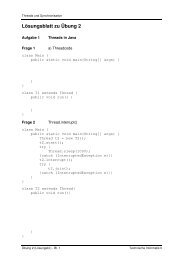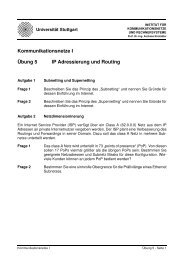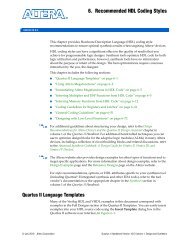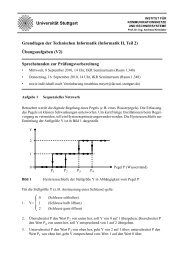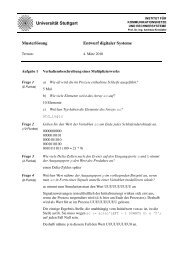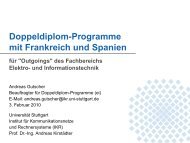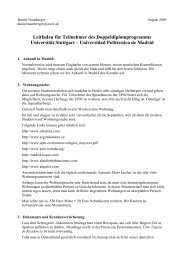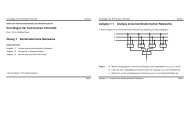Description of the Flow-to-VC Mapping Control Module in DIANA´s ...
Description of the Flow-to-VC Mapping Control Module in DIANA´s ...
Description of the Flow-to-VC Mapping Control Module in DIANA´s ...
You also want an ePaper? Increase the reach of your titles
YUMPU automatically turns print PDFs into web optimized ePapers that Google loves.
<strong>Description</strong> <strong>of</strong> <strong>the</strong> <strong>Flow</strong>-<strong>to</strong>-<strong>VC</strong> <strong>Mapp<strong>in</strong>g</strong><br />
<strong>Control</strong> <strong>Module</strong> <strong>in</strong> <strong>DIANA´s</strong> RSVP over ATM<br />
Architecture<br />
Egil Aarstad<br />
Telenor Research & Development, P.O. Box 83, 2027 Kjeller, Norway<br />
E-mail Egil.Aarstad@telenor.com<br />
Lars Burgstahler, Mart<strong>in</strong> Lorang<br />
University <strong>of</strong> Stuttgart, IND, Pfaffenwaldr<strong>in</strong>g 47, 70569 Stuttgart, Germany<br />
E-mail {lorang, burgstah}@<strong>in</strong>d.uni-stuttgart.de<br />
1 Introduction<br />
Abstract<br />
This paper describes <strong>the</strong> <strong>Flow</strong> <strong>to</strong> <strong>VC</strong> mapp<strong>in</strong>g control module that is embedded <strong>in</strong><br />
<strong>the</strong> RSVP over ATM implementation <strong>of</strong> <strong>the</strong> ACTS project DIANA. As part <strong>of</strong> an<br />
edge router at <strong>the</strong> <strong>in</strong>gress <strong>to</strong> <strong>the</strong> ATM network, this module provides signall<strong>in</strong>g<br />
translation from RSVP <strong>to</strong> ATM, handles <strong>the</strong> admission <strong>of</strong> flows <strong>to</strong> ATM <strong>VC</strong>s and<br />
controls an IP over ATM queue<strong>in</strong>g discipl<strong>in</strong>e. It is thus an example <strong>of</strong> a traffic<br />
descrip<strong>to</strong>r and QoS parameter based resource reservation that strictly guarantees<br />
end-<strong>to</strong>-end QoS. In order <strong>to</strong> address scalability issues, a concept <strong>of</strong> massive<br />
aggregation <strong>of</strong> flows <strong>to</strong> <strong>VC</strong>s and a dynamic bandwidth management is applied <strong>to</strong><br />
reduce <strong>the</strong> control overhead <strong>in</strong>duced by signall<strong>in</strong>g and <strong>the</strong> ma<strong>in</strong>tenance <strong>of</strong> per-flow<br />
state <strong>in</strong>formation. The result<strong>in</strong>g architecture is compared with <strong>the</strong> IP based Scalable<br />
Reservation Pro<strong>to</strong>col SRP and <strong>the</strong> Differentiated Services implementation SIMA.<br />
The performance degradation experienced <strong>in</strong> <strong>the</strong> Internet due <strong>to</strong> frequent bandwidth<br />
bottlenecks is a major obstacle for <strong>in</strong>troduc<strong>in</strong>g multimedia services on a large scale. This<br />
situation has triggered much effort <strong>to</strong> develop and deploy network mechanisms enabl<strong>in</strong>g QoS<br />
support for bandwidth and delay sensitive services. One project with<strong>in</strong> <strong>the</strong> ACTS Research<br />
Programme address<strong>in</strong>g this area is DIANA, Demonstration <strong>of</strong> IP and ATM Interwork<strong>in</strong>g for<br />
real-time Applications. The objective <strong>of</strong> DIANA is <strong>to</strong> develop, <strong>in</strong>tegrate, validate and<br />
demonstrate mechanisms for QoS support and <strong>in</strong>terwork<strong>in</strong>g <strong>in</strong> a heterogeneous network<br />
environment. The project partners are Telscom, Flextel, EPFL, University <strong>of</strong> Stuttgart, ASPA,<br />
Net<strong>Module</strong>, F<strong>in</strong>siel, Nokia, Swisscom and Telenor.<br />
The DIANA project has <strong>in</strong>vestigated a scenario based on Integrated Services [1] where <strong>the</strong><br />
Resource Reservation Pro<strong>to</strong>col (RSVP) [2] is deployed over an ATM core network [11], as<br />
depicted <strong>in</strong> Fig. 1. This is not an unlikely scenario given <strong>the</strong> widespread use <strong>of</strong> ATM as a<br />
backbone technology. However, edge routers are required at <strong>the</strong> border <strong>of</strong> <strong>the</strong> ATM core<br />
network handl<strong>in</strong>g mapp<strong>in</strong>g between IP flows and ATM Virtual Circuits <strong>in</strong> <strong>the</strong> user plane and<br />
correspond<strong>in</strong>g translation between RSVP and ATM signall<strong>in</strong>g <strong>in</strong> <strong>the</strong> control plane. DIANA<br />
implements <strong>the</strong> edge router on <strong>the</strong> Flextel ATM switch<strong>in</strong>g platform, and <strong>the</strong> result<strong>in</strong>g network<br />
element is called <strong>the</strong> DIANA Integration Unit (DIU).
Fig. 1: RSVP over ATM: Edge routers enable QoS <strong>in</strong>terwork<strong>in</strong>g between <strong>the</strong> RSVP/IP and ATM network<br />
doma<strong>in</strong>s<br />
In <strong>the</strong> Integrated Services model reservation state ma<strong>in</strong>tenance <strong>to</strong>ge<strong>the</strong>r with packet<br />
classification and forward<strong>in</strong>g takes place on a per flow basis. S<strong>in</strong>ce this can lead <strong>to</strong> poor<br />
scalability <strong>in</strong> networks carry<strong>in</strong>g numerous small flows, aggregation <strong>of</strong> QoS requests has been<br />
proposed [23, 24]. In DIANA, <strong>the</strong> IntServ/RSVP scalability issue has been addressed by<br />
develop<strong>in</strong>g aggregation functionality <strong>in</strong> <strong>the</strong> DIU allow<strong>in</strong>g numerous small IP flows <strong>to</strong> share one<br />
ATM connection. Fur<strong>the</strong>rmore, an associated dynamic bandwidth management scheme for<br />
connections carry<strong>in</strong>g aggregated traffic has been developed.<br />
In addition <strong>to</strong> <strong>the</strong> RSVP over ATM implementation two o<strong>the</strong>r approaches for QoS support<br />
have been implemented on <strong>the</strong> Flextel switch<strong>in</strong>g platform: Simple Integrated Media Access<br />
(SIMA) [13] and Scalable Reservation Pro<strong>to</strong>col (SRP) [14]. Both SIMA and SRP have been<br />
developed by partners <strong>in</strong> <strong>the</strong> DIANA project. By implement<strong>in</strong>g RSVP over ATM, SIMA and<br />
SRP on <strong>the</strong> same platform, <strong>the</strong> project delivers an open experimental environment for<br />
<strong>in</strong>vestigat<strong>in</strong>g and compar<strong>in</strong>g <strong>the</strong> strengths and weaknesses <strong>of</strong> each approach.<br />
SIMA complies with <strong>the</strong> Differentiated Services (DiffServ) architecture [15] which def<strong>in</strong>es a<br />
scalable framework for QoS support. At <strong>the</strong> border <strong>of</strong> a DiffServ doma<strong>in</strong> packets are classified<br />
<strong>in</strong><strong>to</strong> a few Behaviour Aggregates and marked with a correspond<strong>in</strong>g code-po<strong>in</strong>t <strong>in</strong> <strong>the</strong> IP packet<br />
header [16]. Inside <strong>the</strong> DiffServ doma<strong>in</strong> each Behaviour Aggregate is forwarded on a per hop<br />
basis accord<strong>in</strong>g <strong>to</strong> a specified Per Hop Behaviour (PHB). In this way service differentiation can<br />
be achieved without ma<strong>in</strong>ta<strong>in</strong><strong>in</strong>g per flow state <strong>in</strong>formation. So far <strong>the</strong> IETF DiffServ Work<strong>in</strong>g<br />
Group has def<strong>in</strong>ed two types <strong>of</strong> PHB, Assured Forward<strong>in</strong>g [17] and Expedited Forward<strong>in</strong>g<br />
[18].<br />
On <strong>the</strong> o<strong>the</strong>r hand, SIMA implements a Per Hop Behaviour called Dynamic Real-Time<br />
Non-Real-Time PHB Group [19]. A SIMA sender can emit packets marked as ei<strong>the</strong>r real-time<br />
(rt) or non-real-time (nrt) packets. In access nodes, packets are classified and marked as<br />
belong<strong>in</strong>g <strong>to</strong> one <strong>of</strong> several priority levels depend<strong>in</strong>g on <strong>the</strong> ratio between <strong>the</strong> momentary<br />
Fig. 2: The Simple Integrated Media Access (SIMA) architecture
send<strong>in</strong>g rate and a contracted Nom<strong>in</strong>al Bit Rate.<br />
The SIMA Per Hop Behaviour is implemented <strong>in</strong> <strong>the</strong> Schedul<strong>in</strong>g & Buffer<strong>in</strong>g Unit (SBU) <strong>in</strong><br />
<strong>the</strong> core nodes, see Fig. 2. If a packet arrives at a core node with a Priority Level (PL) less<br />
than <strong>the</strong> threshold level PL A , it will be discarded. O<strong>the</strong>rwise <strong>the</strong> packet will be queued, ei<strong>the</strong>r <strong>in</strong><br />
a real-time or non-real-time queue depend<strong>in</strong>g on <strong>the</strong> packet type. The SBU schedul<strong>in</strong>g<br />
discipl<strong>in</strong>e is based on strict delay priority, thus <strong>the</strong> non-real-time queue will be served only<br />
when <strong>the</strong> real-time queue is empty. The priority threshold level PL A changes dynamically as a<br />
function <strong>of</strong> <strong>the</strong> congestion level <strong>in</strong> <strong>the</strong> node, i.e. accord<strong>in</strong>g <strong>to</strong> <strong>the</strong> buffer occupancy levels <strong>in</strong> <strong>the</strong><br />
rt- and nrt-queues. If <strong>the</strong> congestion level <strong>in</strong>creases, <strong>the</strong> priority level threshold is <strong>in</strong>creased,<br />
<strong>the</strong>reby allow<strong>in</strong>g a larger portion <strong>of</strong> packets <strong>to</strong> be discarded.<br />
The Scalable Reservation Pro<strong>to</strong>col is a novel approach for QoS support <strong>in</strong> IP networks<br />
provid<strong>in</strong>g dynamic resource reservation as <strong>in</strong> Integrated Services while ma<strong>in</strong>ta<strong>in</strong><strong>in</strong>g scalability<br />
similar <strong>to</strong> Differentiated Services. The scalability is achieved by mak<strong>in</strong>g reservations on a per<br />
hop basis and only for traffic aggregates.<br />
Fig. 3 shows <strong>the</strong> ma<strong>in</strong> components <strong>of</strong> <strong>the</strong> SRP architecture. Simply expla<strong>in</strong>ed, an SRP<br />
sender can mark packets ei<strong>the</strong>r as Reserved (Resv), Request (Req) or Best-Effort (BE)<br />
packets. Reserved packets correspond <strong>to</strong> packets for which resources have been reserved <strong>in</strong><br />
<strong>the</strong> routers. These packets are forwarded unchanged through <strong>the</strong> network. On <strong>the</strong> o<strong>the</strong>r hand,<br />
Request packets, which correspond <strong>to</strong> packets request<strong>in</strong>g resource reservation, will only be<br />
admitted and forwarded as Request packets if sufficient free resources are available <strong>in</strong> <strong>the</strong><br />
routers. In this case <strong>the</strong> routers allocate resources <strong>to</strong> <strong>the</strong> Request packets. O<strong>the</strong>rwise <strong>the</strong><br />
Request packets will be downgraded <strong>to</strong> Best-Effort. A receiver returns feedback <strong>to</strong> <strong>the</strong> sender<br />
about <strong>the</strong> amount <strong>of</strong> Reserved and Request packets received. From this <strong>in</strong>formation <strong>the</strong> sender<br />
estimates <strong>the</strong> amount <strong>of</strong> resources that have been established for <strong>the</strong> Request packets and will<br />
start emitt<strong>in</strong>g Reserved packets accord<strong>in</strong>gly. In o<strong>the</strong>r words SRP provides a dynamic feedback<br />
control loop for establish<strong>in</strong>g resource reservations <strong>in</strong> <strong>the</strong> network. The SRP implementation<br />
makes use <strong>of</strong> <strong>the</strong> Differentiated Services framework for packet mark<strong>in</strong>g and Per Hop<br />
Behaviour.<br />
This paper focuses on <strong>the</strong> <strong>Flow</strong> <strong>to</strong> <strong>VC</strong> mapp<strong>in</strong>g control module embedded <strong>in</strong> <strong>the</strong> RSVP<br />
over ATM implementation. Its pro<strong>to</strong>col and process architecture is expla<strong>in</strong>ed <strong>in</strong> section 2. The<br />
flow mapp<strong>in</strong>g and signall<strong>in</strong>g translation functions are implemented by a IP flow-<strong>to</strong>-<strong>VC</strong><br />
<strong>Mapp<strong>in</strong>g</strong> module (F2VM), whereas operations related <strong>to</strong> ATM <strong>VC</strong>s management are<br />
implemented <strong>in</strong> a <strong>VC</strong> Set-up and Modification <strong>Module</strong> (VSMM). An overview <strong>of</strong> <strong>the</strong>se<br />
modules is given <strong>in</strong> section 3. The associated traffic control and resource allocation functions<br />
are described <strong>in</strong> section 4. The dynamic bandwidth management scheme has been analysed with<br />
respect <strong>to</strong> trade-<strong>of</strong>f between signall<strong>in</strong>g load and bandwidth utilisation. The results <strong>of</strong> this<br />
analysis is presented <strong>in</strong> section 5. F<strong>in</strong>ally, <strong>the</strong> RSVP over ATM architecture is compared with<br />
Fig. 3: The Scalable Reservation Pro<strong>to</strong>col (SRP) architecture
<strong>the</strong> SIMA and SRP alternative.<br />
2 Pro<strong>to</strong>col and Process Architecture<br />
RSVP over ATM architecture [2, 3, 4, 7, 8, 9, 10, 11, 12] is an example <strong>of</strong> a traffic descrip<strong>to</strong>r<br />
and QoS parameter based resource reservation that strictly guarantees end-<strong>to</strong>-end QoS. In<br />
order <strong>to</strong> address scalability issues, DIANA realises a concept <strong>of</strong> massive aggregation <strong>of</strong> flows<br />
<strong>to</strong> <strong>VC</strong>s similar <strong>to</strong> [23, 24,] <strong>to</strong> reduce <strong>the</strong> control overhead <strong>in</strong>duced by signall<strong>in</strong>g and <strong>the</strong><br />
ma<strong>in</strong>tenance <strong>of</strong> per-flow state <strong>in</strong>formation <strong>in</strong> <strong>the</strong> core network.<br />
Therefore, <strong>DIANA´s</strong> RSVP over ATM traffic control architecture is implemented <strong>in</strong> a<br />
router that represents <strong>the</strong> border between an IP network and an ATM network, at a po<strong>in</strong>t<br />
where a sufficiently large number <strong>of</strong> IP flows can be aggregated and transferred on a common<br />
<strong>VC</strong> <strong>to</strong>wards <strong>the</strong> egress <strong>of</strong> <strong>the</strong> ATM network. The router pro<strong>to</strong>type implementation unifies<br />
RSVP signall<strong>in</strong>g, Integrated Services traffic control, flow-<strong>to</strong>-<strong>VC</strong> mapp<strong>in</strong>g, CLIP IP over ATM<br />
address resolution [22] and UNI 4.0 [21] signall<strong>in</strong>g <strong>in</strong> a work<strong>in</strong>g ensemble, see Fig. 4.<br />
The controll<strong>in</strong>g RSVP demon process starts <strong>in</strong>teract<strong>in</strong>g with ATM traffic control when<br />
traffic control related RSVP messages arrive. For this purpose, RSVP has been enhanced with<br />
an ATM specific L<strong>in</strong>k Layer Dependent Adaptation Layer (LLDAL). <strong>DIANA´s</strong> LLDAL<br />
implementation is separated <strong>in</strong><strong>to</strong> a traffic control adaptation <strong>to</strong> RSVP and a demon process<br />
ATMTCD that controls most <strong>of</strong> <strong>the</strong> <strong>in</strong>terwork<strong>in</strong>g tasks (address resolution, signall<strong>in</strong>g<br />
translation) and traffic management functions (flow-<strong>to</strong>-<strong>VC</strong> mapp<strong>in</strong>g, dynamic bandwidth<br />
management, queue management & schedulers).<br />
Fig. 4: <strong>DIANA´s</strong> RSVP over ATM traffic control architecture
3 Overview <strong>of</strong> <strong>the</strong> ATMTCD<br />
The ATM traffic control demon process (ATMTCD) is not only <strong>in</strong> charge <strong>of</strong> handl<strong>in</strong>g<br />
communication with RSVP and <strong>the</strong> L<strong>in</strong>ux kernel traffic control but also <strong>in</strong> controll<strong>in</strong>g its<br />
subord<strong>in</strong>ate modules <strong>Flow</strong>-<strong>to</strong>-<strong>VC</strong> <strong>Mapp<strong>in</strong>g</strong> <strong>Control</strong> <strong>Module</strong> (F2VM) and <strong>VC</strong> Set-up and<br />
Modification <strong>Module</strong> (VSMM) which carry out actions related with <strong>the</strong> mapp<strong>in</strong>g from an IP<br />
flow <strong>to</strong> an ATM <strong>VC</strong> and <strong>the</strong> dynamic set-up and modification <strong>of</strong> <strong>VC</strong>s follow<strong>in</strong>g <strong>the</strong> rules <strong>of</strong> a<br />
dynamic threshold based bandwidth management scheme.<br />
3.1 The <strong>Flow</strong>-<strong>to</strong>-<strong>VC</strong> <strong>Mapp<strong>in</strong>g</strong> <strong>Control</strong> <strong>Module</strong><br />
As its name suggests, <strong>the</strong> <strong>Flow</strong>-<strong>to</strong>-<strong>VC</strong> <strong>Mapp<strong>in</strong>g</strong> <strong>Control</strong> <strong>Module</strong> (F2VM) is a set <strong>of</strong> functions<br />
that carry out actions related with <strong>the</strong> mapp<strong>in</strong>g from an IP flow <strong>to</strong> an ATM <strong>VC</strong>. F2VM is an<br />
<strong>in</strong>tegral part <strong>of</strong> <strong>the</strong> ATMTCD. More specifically, it controls an architecture compris<strong>in</strong>g <strong>the</strong><br />
follow<strong>in</strong>g <strong>in</strong>terwork<strong>in</strong>g and traffic control functions:<br />
Aggregation filters and flow records<br />
The F2VM creates, modifies or deletes entries <strong>in</strong> its <strong>Flow</strong>-<strong>to</strong>-<strong>VC</strong> mapp<strong>in</strong>g table. Those entries<br />
are called F2VM records. Such a record collects <strong>in</strong>formation about a s<strong>in</strong>gle <strong>VC</strong> and all <strong>the</strong><br />
flows mapped <strong>to</strong> that <strong>VC</strong>. Of course only flows whose egress Integration Unit IP addresses<br />
match can be mapped <strong>to</strong> <strong>the</strong> same record. Moreover, an aggregation filter at <strong>the</strong> entry <strong>of</strong> each<br />
record ensures that only flow requests that also match <strong>the</strong> record´s aggregation criterion are<br />
mapped <strong>to</strong> <strong>the</strong> <strong>VC</strong> associated with that record.<br />
ATM address resolution and signall<strong>in</strong>g translation:<br />
Whenever <strong>the</strong> F2VM cannot assign an <strong>in</strong>com<strong>in</strong>g RSVP reservation request <strong>to</strong> one <strong>of</strong> <strong>the</strong><br />
exist<strong>in</strong>g F2VM records, i.e. if none <strong>of</strong> <strong>the</strong> next RSVP hop fields and aggregation filters (see<br />
below) matches, <strong>the</strong> F2VM creates a new record, starts <strong>the</strong> address resolution procedure, and,<br />
if this succeeds, calculates <strong>the</strong> ATM traffic control parameters and f<strong>in</strong>ally triggers <strong>the</strong> ATM<br />
signall<strong>in</strong>g demon <strong>to</strong> set-up a new ATM <strong>VC</strong>. When <strong>the</strong> ATM connection is ready, ATMTCD<br />
sends a confirmation back <strong>to</strong> <strong>the</strong> RSVP demon which <strong>the</strong>n forwards <strong>the</strong> reservation message<br />
<strong>to</strong>wards <strong>the</strong> sender.<br />
Asynchronous ATM <strong>VC</strong> set-up and modification<br />
In order <strong>to</strong> reduce <strong>the</strong> control overhead <strong>in</strong>duced by signall<strong>in</strong>g for a s<strong>in</strong>gle flow with a possibly<br />
Fig 5: <strong>Flow</strong>-<strong>to</strong>-<strong>VC</strong> mapp<strong>in</strong>g and dynamic bandwidth management
low bandwidth demand and short lifetime, a dynamic bandwidth management scheme renegotiates<br />
reserved ATM bandwidth [25] <strong>of</strong> a record only when <strong>the</strong> resource calculation for<br />
<strong>the</strong> flows mapped <strong>to</strong> that record yields a bandwidth that crosses a re-negotiation threshold.<br />
Those thresholds will be tuned <strong>in</strong> a way that avoids re-negotiation <strong>to</strong> an extent that can be<br />
justified by economic considerations <strong>in</strong> terms <strong>of</strong> over-allocated bandwidth and signall<strong>in</strong>g<br />
process<strong>in</strong>g overhead. This means that new flows can <strong>of</strong>ten be granted prior <strong>to</strong> re-negotiation<br />
by exploit<strong>in</strong>g <strong>the</strong> safety marg<strong>in</strong>s. In this case, re-negotiation can be carried out asynchronously.<br />
As expla<strong>in</strong>ed <strong>in</strong> more detail below, <strong>the</strong> VSMM is able <strong>to</strong> handle set-up and modification<br />
requests asynchronously and is thus a pre-requisite for <strong>the</strong> dynamic bandwidth management<br />
scheme. The behaviour <strong>of</strong> <strong>the</strong> system is sketched <strong>in</strong> Fig. 5.<br />
Queue<strong>in</strong>g and schedul<strong>in</strong>g<br />
The RSVP over ATM process ensemble <strong>in</strong>troduced <strong>in</strong> Fig. 4 controls an IP over ATM priority<br />
queue<strong>in</strong>g discipl<strong>in</strong>e that <strong>in</strong>cludes a RPQ scheduler [27] ensur<strong>in</strong>g isolation <strong>of</strong> Guaranteed<br />
Service flows with different delay requirements if <strong>the</strong>y are aggregated <strong>to</strong> <strong>the</strong> same <strong>VC</strong>s.<br />
For <strong>Control</strong>led Load service flows that do not <strong>in</strong>clude delay bound <strong>in</strong>formation, separate<br />
FIFO queues are used. In addition, a default queue for best-effort traffic is foreseen. Unlike <strong>the</strong><br />
o<strong>the</strong>r classes, <strong>the</strong> default best-effort class does not filter traffic. Fur<strong>the</strong>rmore, it is <strong>the</strong> only<br />
„class“ that does not have a <strong>VC</strong> <strong>of</strong> its own but uses CLIP <strong>in</strong> a standard fashion. More details<br />
are given <strong>in</strong> section 4. The queue<strong>in</strong>g discipl<strong>in</strong>e concept depicted <strong>in</strong> Fig. 4 is conformant <strong>to</strong> <strong>the</strong><br />
generic L<strong>in</strong>ux kernel traffic control framework [26].<br />
As an additional feature, <strong>the</strong> queue<strong>in</strong>g discipl<strong>in</strong>e assigns dedicated RSVP over ATM control<br />
CBR-<strong>VC</strong>s <strong>to</strong> protect RSVP signall<strong>in</strong>g messages that would o<strong>the</strong>rwise be forwarded via CLIP<br />
(UBR-<strong>VC</strong>s) from be<strong>in</strong>g dropped when congestion occurs.<br />
The F2VM is <strong>in</strong> charge <strong>of</strong> <strong>in</strong>stall<strong>in</strong>g <strong>the</strong> IP packet filters that allow <strong>to</strong> map packets <strong>to</strong> <strong>the</strong><br />
classes that provide <strong>the</strong> forward<strong>in</strong>g behaviour specified through RSVP signall<strong>in</strong>g.<br />
3.2 The <strong>VC</strong> Setup and Modification <strong>Module</strong><br />
The <strong>VC</strong> Setup and Modification <strong>Module</strong> (VSMM) controls <strong>the</strong> setup, modification and release<br />
<strong>of</strong> ATM <strong>VC</strong>s. With<strong>in</strong> <strong>the</strong> ATMTCD, <strong>the</strong> VSMM <strong>in</strong>teracts with <strong>the</strong> <strong>Flow</strong>-<strong>to</strong>-<strong>VC</strong> <strong>Mapp<strong>in</strong>g</strong><br />
<strong>Module</strong> (F2VM) and <strong>the</strong> ATM API. Fig. 4 above shows how <strong>the</strong> VSMM is embedded <strong>in</strong> <strong>the</strong><br />
Integration Unit’s architecture.<br />
All functions that are directly related <strong>to</strong> <strong>VC</strong> manipulation work asynchronously <strong>to</strong> avoid<br />
that <strong>the</strong> ATMTCD has <strong>to</strong> wait for successful completion <strong>of</strong> <strong>VC</strong> setup, modification or release<br />
requests. Although USC´s RSVP demon does not support asynchronous operation with <strong>the</strong><br />
LLDAL, asynchronous re-negotiation is still useful <strong>to</strong> <strong>in</strong>crease an aggregate’s bandwidth once<br />
<strong>the</strong> calculated bandwidth enters a buffer zone without exceed<strong>in</strong>g <strong>the</strong> actual <strong>VC</strong> bandwidth. For<br />
o<strong>the</strong>r requests can be accepted and <strong>the</strong> correspond<strong>in</strong>g control processes started while previous<br />
requests are still be<strong>in</strong>g processed by remote switches, routers or <strong>the</strong> peer end system.<br />
Whenever available, non-block<strong>in</strong>g API functions are used. Miss<strong>in</strong>g asynchronous API<br />
functionality is compensated us<strong>in</strong>g suitable UNIX <strong>in</strong>terprocess communication mechanisms. In<br />
this way, <strong>the</strong> VSMM can <strong>of</strong>ten quickly respond <strong>to</strong> F2VM requests without await<strong>in</strong>g <strong>the</strong> end <strong>of</strong><br />
ATM process<strong>in</strong>g. Regular poll<strong>in</strong>g ensures that ATM updates are taken <strong>in</strong><strong>to</strong> account later. As<br />
long as no updates occur, <strong>the</strong> ATMTCD can accomplish o<strong>the</strong>r tasks. Fig. 6 shows an example<br />
for a <strong>VC</strong> setup be<strong>in</strong>g done us<strong>in</strong>g non-block<strong>in</strong>g ATM API functions. As <strong>in</strong>dicated, VSMM is<br />
able <strong>to</strong> handle several set-up requests quasi simultaneously. The f<strong>in</strong>al result, or more precisely,<br />
its impact on pend<strong>in</strong>g flow requests are communicated <strong>to</strong> <strong>the</strong> RSVP demon.<br />
As child processes can use all <strong>the</strong> data already available <strong>in</strong> <strong>the</strong> parent process but work
Fig. 6: ATM connection setup<br />
Fig. 7: ATM connection modification<br />
<strong>in</strong>dependently and s<strong>in</strong>ce <strong>the</strong> L<strong>in</strong>ux ATM API does not moni<strong>to</strong>r <strong>the</strong> result <strong>of</strong> an asynchronous<br />
<strong>VC</strong> modification, this method is used for re-negotiation. While <strong>the</strong> parent process can accept<br />
new requests, <strong>the</strong> child starts re-negotiation and waits for <strong>the</strong> result. After hav<strong>in</strong>g delivered <strong>the</strong><br />
result <strong>to</strong> <strong>the</strong> parent process, <strong>the</strong> child term<strong>in</strong>ates itself. Fig. 7 illustrates <strong>the</strong> course <strong>of</strong> a renegotiation.<br />
Several re-negotiations can be done quasi simultaneously, but for each one a new<br />
child process is launched.<br />
4 Traffic <strong>Control</strong> and Resource Allocation Functions<br />
IP network elements that support service guarantees have <strong>to</strong> be able <strong>to</strong> differentiate between<br />
flows and <strong>to</strong> forward packets <strong>in</strong> accordance with a traffic contract agreed upon between <strong>the</strong><br />
network and <strong>the</strong> user. As a consequence, scarce resources, which means <strong>in</strong> this paper<br />
bandwidth and buffer, have <strong>to</strong> distributed <strong>to</strong> flows tak<strong>in</strong>g <strong>in</strong><strong>to</strong> account <strong>the</strong>ir specific<br />
requirements. Although <strong>the</strong> number <strong>of</strong> flows that require (strict) service guarantees does not<br />
<strong>in</strong>crease as fast as <strong>the</strong> number <strong>of</strong> best-effort flows, this differentiation is likely not <strong>to</strong> scale well.<br />
Aggregation <strong>of</strong> flows <strong>to</strong> a s<strong>in</strong>gle flow, e.g. as represented by an ATM <strong>VC</strong>, promises <strong>to</strong> solve<br />
that problem. However, when an aggregate is built up, resource allocation and schedul<strong>in</strong>g has<br />
<strong>to</strong> make sure that <strong>the</strong> QoS requirements <strong>of</strong> each flow is respected.<br />
S<strong>in</strong>ce <strong>the</strong> additional control overhead <strong>in</strong>duced by schedul<strong>in</strong>g, typically <strong>the</strong> order<strong>in</strong>g <strong>of</strong><br />
packets <strong>in</strong> a sorted list, is significant, rotat<strong>in</strong>g priority queues (RPQ) and a correspond<strong>in</strong>g<br />
resource allocation [27] have been <strong>in</strong>tegrated <strong>to</strong> <strong>DIANA´s</strong> IP over ATM queue<strong>in</strong>g discipl<strong>in</strong>e <strong>to</strong><br />
support Guaranteed Service. RPQ only approximates sort<strong>in</strong>g <strong>of</strong> packets that is usually done<br />
based on transmission deadl<strong>in</strong>es or similar time <strong>in</strong>formation and thus greatly simplifies<br />
schedul<strong>in</strong>g, <strong>of</strong> course at <strong>the</strong> price <strong>of</strong> a reduced accuracy <strong>of</strong> its schedul<strong>in</strong>g decisions and<br />
resource allocation. In this section, <strong>the</strong> performance <strong>of</strong> RPQ is <strong>in</strong>vestigated, partly based on <strong>the</strong><br />
worst case analysis given <strong>in</strong> [27] and partly based on simulation. Besides, it is demonstrated<br />
how RPQ fits <strong>in</strong><strong>to</strong> <strong>DIANA´s</strong> flow aggregation concept.<br />
The RPQ scheduler ma<strong>in</strong>ta<strong>in</strong>s P+1 priority ordered FIFO queues <strong>to</strong> handle P priorities.<br />
Those queues rotate at <strong>the</strong> end <strong>of</strong> a rotation <strong>in</strong>terval ∆. This means that <strong>the</strong> queue with <strong>the</strong><br />
previously highest priority is removed from <strong>the</strong> <strong>to</strong>p and appended <strong>to</strong> <strong>the</strong> end <strong>of</strong> <strong>the</strong> priority<br />
sorted list <strong>of</strong> queues. S<strong>in</strong>ce packets with priority p, p = 1, ..., P are <strong>in</strong>serted <strong>in</strong><strong>to</strong> <strong>the</strong> queue with<br />
<strong>the</strong> current <strong>in</strong>dex p, i.e. noth<strong>in</strong>g is <strong>in</strong>serted <strong>to</strong> <strong>the</strong> <strong>to</strong>p queue anymore, and s<strong>in</strong>ce resource<br />
allocation and polic<strong>in</strong>g ensures that none <strong>of</strong> <strong>the</strong> queues overflows, a determ<strong>in</strong>istic, delay<br />
bounded service as required by Guaranteed Service [6] can be realised.<br />
Provided <strong>the</strong> maximum traffic arrivals from a flow j is bounded by a right-cont<strong>in</strong>uous<br />
subadditive traffic constra<strong>in</strong>t function A j (t), a given set <strong>of</strong> connections characterised by a tuple
consist<strong>in</strong>g <strong>of</strong> this traffic constra<strong>in</strong>t function and <strong>the</strong> specified delay bound {A j (t), d j } is<br />
schedulable with a certa<strong>in</strong> schedul<strong>in</strong>g method if for all t>0 no packet exceeds its delay bound<br />
d j .<br />
In [27], schedulability conditions (1) have been derived based on a determ<strong>in</strong>istic worst case<br />
analysis for each priority p (Below, p is used <strong>to</strong> number schedulability conditions). Ct denotes<br />
<strong>the</strong> service curve.<br />
( )<br />
∑ j 1<br />
j∈C<br />
Ct ≥ A t − d + max s<br />
1<br />
max<br />
i<br />
i∈ C , q><br />
1<br />
q<br />
d1 ≤ t < d2<br />
− ∆<br />
P<br />
( 1) ∑ ∑ j ( ∆<br />
q )<br />
max d p − ∆ ≤ t < d p+<br />
1 −<br />
Ct ≥ ∑ Aj<br />
t − d + A t + − d + max s<br />
i∈ C q p i<br />
q , ><br />
2 ≤ p < P<br />
j∈C1<br />
∑<br />
q=<br />
2 j∈Cq<br />
( q)<br />
Ct ≥ A ( t − d ) + A t + ∆ − d<br />
t ≥ d P − ∆<br />
j∈C1<br />
j<br />
1<br />
P<br />
∑<br />
∑<br />
q=<br />
2 j∈Cq<br />
j<br />
∆<br />
(1)<br />
In <strong>the</strong> follow<strong>in</strong>g, a fluid idealisation <strong>of</strong> those schedulability conditions is <strong>of</strong>ten used <strong>to</strong> derive<br />
guidel<strong>in</strong>es for <strong>the</strong> use <strong>of</strong> RPQ, i.e. <strong>the</strong> terms<br />
max<br />
s<br />
max<br />
i<br />
i∈ Cq<br />
, q>1<br />
and<br />
max<br />
s<br />
max<br />
i<br />
i ∈ C q , q > p<br />
that account for <strong>the</strong> maximum packet transmission time <strong>of</strong> packets from flow i that cannot be<br />
pre-empted are ignored. Throughout this paper, traffic constra<strong>in</strong>t functions <strong>of</strong> type (2) are<br />
used,<br />
A ( t) = m<strong>in</strong>( p t, σ + ρ t)<br />
(2)<br />
j j j j<br />
where p j and ρ j denote rate parameters that can be <strong>in</strong>terpreted as a <strong>the</strong> peak and mean rate <strong>of</strong><br />
flow j, σ j is a burst parameter. Hence, (2) specifies a traffic constra<strong>in</strong>t function that is<br />
characterised by a f<strong>in</strong>ite peak rate p j . This has some important implications:<br />
With Guaranteed Service, <strong>the</strong> amount <strong>of</strong> data sent must not exceed M+pt for all times t,<br />
with M denot<strong>in</strong>g <strong>the</strong> maximum packet size and p <strong>the</strong> peak rate as <strong>in</strong>dicated <strong>in</strong> <strong>the</strong> Integrated<br />
Services traffic descrip<strong>to</strong>r TSpec. If one <strong>in</strong>serts p for p j <strong>in</strong> (2), packet arrivals may exceed <strong>the</strong><br />
traffic constra<strong>in</strong>t function. As a consequence, (2) can only be <strong>in</strong>terpreted as a fluid idealisation<br />
<strong>of</strong> <strong>the</strong> actual traffic constra<strong>in</strong>t function <strong>in</strong> this case. Alternatively, p j . could be set <strong>to</strong> <strong>the</strong> l<strong>in</strong>k<br />
rate but this impairs <strong>the</strong> efficiency <strong>of</strong> <strong>the</strong> RPQ resource allocation significantly s<strong>in</strong>ce a source<br />
with lower p j nestles more closely aga<strong>in</strong>st a l<strong>in</strong>ear service curve which yields a lower delay.<br />
The second implication <strong>of</strong> <strong>the</strong> choice (2) concerns <strong>the</strong> verification <strong>of</strong> <strong>the</strong> schedulability<br />
conditions (1). S<strong>in</strong>ce <strong>the</strong> schedulability conditions have <strong>to</strong> be met for all times t, <strong>the</strong> most<br />
critical time has <strong>to</strong> be found, i.e. <strong>the</strong> time at which delay is maximum. Due <strong>to</strong> <strong>the</strong><br />
characteristics <strong>of</strong> <strong>the</strong> used traffic constra<strong>in</strong>t functions, this is <strong>the</strong> time <strong>in</strong>stant at which <strong>the</strong> slope<br />
<strong>of</strong> <strong>the</strong> sum <strong>of</strong> <strong>the</strong> traffic constra<strong>in</strong>t functions A j on <strong>the</strong> right side <strong>of</strong> (1) crosses <strong>the</strong> slope C <strong>of</strong><br />
<strong>the</strong> service curve. If this does not happen dur<strong>in</strong>g <strong>the</strong> time <strong>in</strong>terval relevant for a schedulability<br />
condition, <strong>the</strong> left <strong>in</strong>terval boundary is <strong>the</strong> most critical time if <strong>the</strong> slope <strong>of</strong> <strong>the</strong> sum is already<br />
smaller than C at that time or <strong>the</strong> right <strong>in</strong>terval boundary <strong>in</strong> <strong>the</strong> opposite case, however, <strong>the</strong><br />
latter condition is covered by <strong>the</strong> subsequent schedulability condition. S<strong>in</strong>ce <strong>the</strong> schedulability<br />
conditions are disjunct on <strong>the</strong> time axis, only one critical time per flow type has <strong>to</strong> be checked.<br />
For each <strong>of</strong> those critical times, a separate calculation is required s<strong>in</strong>ce it is not clear <strong>in</strong> advance<br />
which <strong>of</strong> <strong>the</strong> critical times forms <strong>the</strong> bottleneck for <strong>the</strong> schedulability conditions as a whole.
Maximum Traffic Volume [kbyte]<br />
5,0<br />
4,0<br />
3,0<br />
2,0<br />
1,0<br />
Burst<strong>in</strong>ess 10 - Delay class 10 ms<br />
Burst<strong>in</strong>ess 10 - Delay class 100 ms<br />
Burst<strong>in</strong>ess 2 - Delay class 10 ms<br />
Burst<strong>in</strong>ess 2 - Delay class 100 ms<br />
Normalised Admission Region Volume<br />
1,0<br />
0,9<br />
0,8<br />
0,7<br />
Burst<strong>in</strong>ess 10<br />
Burst<strong>in</strong>ess 2<br />
0,0<br />
0 100 200 300 400 500<br />
Time [ms]<br />
Fig. 8: Construction <strong>of</strong> traffic constra<strong>in</strong>t functions for<br />
sources with variable burst<strong>in</strong>ess<br />
1 2 3 4 5 6 7 8 9 10<br />
Rotation Interval [ms]<br />
Fig. 9: Normalised volume <strong>of</strong> <strong>the</strong> admission region as<br />
a function <strong>of</strong> <strong>the</strong> rotation <strong>in</strong>terval ∆<br />
F<strong>in</strong>ally, a traffic constra<strong>in</strong>t function with f<strong>in</strong>ite peak rate mitigates <strong>the</strong> negative impact <strong>of</strong> a<br />
large rotation <strong>in</strong>terval ∆ on <strong>the</strong> required service rate C. This was a major concern and reason<br />
for an improvement <strong>of</strong> RPQ <strong>in</strong> [28]. The time <strong>in</strong>stants at which <strong>the</strong> schedulability conditions<br />
are checked move <strong>to</strong> <strong>the</strong> right (as compared <strong>to</strong> a system with <strong>in</strong>f<strong>in</strong>ite peak rate, where <strong>the</strong>re is<br />
only one critical time at <strong>the</strong> beg<strong>in</strong>n<strong>in</strong>g <strong>of</strong> an <strong>in</strong>terval) and t-∆ <strong>in</strong> (1) gets less sensitive <strong>to</strong><br />
changes <strong>of</strong> ∆ (∆≤d 1 ). Fig. 9 demonstrates this effect with two source types that are<br />
constructed as depicted <strong>in</strong> Fig. 8 <strong>in</strong> a way that <strong>the</strong>y differ <strong>in</strong> terms <strong>of</strong> <strong>the</strong>ir burst<strong>in</strong>ess but <strong>the</strong>ir<br />
traffic constra<strong>in</strong>t functions still converge. The exact parameters can be found <strong>in</strong> Table 1. Note<br />
Table 1: Source parameters (t q denotes <strong>the</strong> maximum duration <strong>of</strong> a burst)<br />
Fig. d q /ms p q /C ρ q /C t q /ms s q /byte No. Remarks<br />
10 0.05 0.005 5 fluid all<br />
8, 9 20 0.05 0.005 10 fluid all burst<strong>in</strong>ess 10<br />
50 0.05 0.005 25 fluid all<br />
100 0.05 0.005 50 fluid all<br />
10 0.01 0.005 45 fluid all<br />
8, 9 20 0.01 0.005 90 fluid all burst<strong>in</strong>ess 2<br />
50 0.01 0.005 225 fluid all<br />
100 0.01 0.005 450 fluid all<br />
10 0.05 0.005 5 fluid 60 load: 0.575 C<br />
10 20 0.05 0.005 10 fluid 19 max. load if only one source type<br />
50 0.05 0.005 25 fluid 22 is present: 0.3 C<br />
100 0.05 0.005 50 fluid 14<br />
20 0.01 0.005 90 fluid 76 load: 0.78 C<br />
11 50 0.01 0.005 100 fluid 40 max. load if only one source type<br />
100 0.01 0.005 110 fluid 40 is present: 0.61 C, 0.75 C, 0.95 C<br />
10 0.05 0.005 5 125 60 ON-OFF sources with<br />
12 20 0.05 0.005 10 125 13 determ<strong>in</strong>istic ON phase and<br />
50 0.05 0.005 25 125 23 and<br />
100 0.05 0.005 50 125 15 Erlang-10 distributed OFF phase<br />
10 0.01 0.005 45 113 110 ON-OFF sources with<br />
13 20 0.01 0.005 90 113 11 determ<strong>in</strong>istic ON phase and<br />
50 0.01 0.005 225 113 11 and<br />
100 0.01 0.005 450 113 33 Erlang-10 distributed OFF phase
1,0<br />
0,9<br />
1,0<br />
Delay class 100 ms<br />
Delay class 50 ms<br />
Delay class 20 ms<br />
Required Bandwidth<br />
0,8<br />
0,7<br />
0,6<br />
Required Bandwidth<br />
0,8<br />
0,6<br />
0,5<br />
0,4<br />
Delay class 10 ms<br />
Delay class 20 ms<br />
Delay class 50 ms<br />
Delay class 100 ms<br />
0,4<br />
1 2 3 4<br />
1 2 3<br />
Schedulability Condition<br />
Schedulability Condition<br />
Fig. 10: Schedulability conditions for a balanced<br />
traffic mix (∆ = 1 ms)<br />
Fig. 11: Schedulability conditions for an unbalanced<br />
traffic mix (∆ = 10 ms)<br />
that <strong>the</strong> admission region volume is normalised <strong>to</strong> <strong>the</strong> respective flow type maximum with a<br />
rotation <strong>in</strong>terval <strong>of</strong> 1 ms.<br />
In order <strong>to</strong> illustrate <strong>the</strong> efficiency <strong>of</strong> <strong>the</strong> RPQ system, various admission regions have been<br />
computed. Fig. 10 is obta<strong>in</strong>ed with a traffic mix that is composed <strong>of</strong> sources <strong>the</strong> critical times<br />
<strong>of</strong> which lie <strong>in</strong> different schedulability conditions. As a consequence, <strong>the</strong> resource demand is<br />
distributed almost equally among <strong>the</strong> different schedulability conditions. The admissible load<br />
reaches 0.575 whereas <strong>the</strong> presence <strong>of</strong> sources <strong>of</strong> a s<strong>in</strong>gle type would approximately yield 0.03<br />
(Table 1). Fig. 11 shows a counter-example where all critical times and thus <strong>the</strong>ir maximum<br />
demand <strong>of</strong> <strong>the</strong> sources <strong>in</strong>volved lie <strong>in</strong> a s<strong>in</strong>gle schedulability condition, <strong>in</strong> this case number 3.<br />
As a result, <strong>the</strong> maximum demand is not balanced and <strong>the</strong> lower schedulability conditions<br />
rema<strong>in</strong> unsaturated.<br />
Hence, if ∆ approaches zero and if <strong>the</strong> packet terms <strong>in</strong> (1) are still ignored, <strong>the</strong><br />
schedulability conditions (1) converge <strong>to</strong><br />
∑<br />
P<br />
( 1) ∑ ∑ j ( q )<br />
Ct ≥ A t − d + A t − d<br />
j∈C1<br />
j<br />
q=<br />
2 j∈Cq<br />
Such a system would always outperform a FIFO based queue<strong>in</strong>g system that separates flows<br />
with different delay requirements [29]. Although real systems may significantly deviate from<br />
this ideal case, <strong>the</strong> results shown <strong>in</strong> Fig. 10 show that a RPQ system that aggregates all<br />
Guaranteed Service flows with a reasonably small ∆ (significantly smaller than d 1 ) is <strong>in</strong> most<br />
cases more efficient unless <strong>the</strong> delay requirements <strong>of</strong> a flow do not match <strong>the</strong> range or<br />
resolution (∆) <strong>of</strong>fered by <strong>the</strong> RPQ system and/or <strong>the</strong> maximum packet transmission time is<br />
large and - at <strong>the</strong> same time - <strong>the</strong> demand <strong>of</strong> <strong>the</strong> traffic mix under consideration cannot be<br />
distributed <strong>to</strong> <strong>the</strong> schedulability conditions <strong>in</strong> a balanced way.<br />
Never<strong>the</strong>less, <strong>the</strong> results <strong>of</strong> simulative performance studies that are depicted <strong>in</strong> Fig. 12 and<br />
13 show that a system with s<strong>to</strong>chastic sources is usually far away from approach<strong>in</strong>g <strong>the</strong> worst<br />
case scenario which <strong>the</strong> derivation <strong>of</strong> <strong>the</strong> schedulability conditions bases upon.<br />
The results presented <strong>in</strong> Fig. 12 and 13 are obta<strong>in</strong>ed for traffic mixes that yield a maximum<br />
load among <strong>the</strong> source comb<strong>in</strong>ations that lie with<strong>in</strong> <strong>the</strong> admission region calculated for <strong>the</strong><br />
respective parameter set. This means that a guaranteed service with determ<strong>in</strong>istic delay bounds<br />
and zero loss is only achievable with a generous reservation <strong>of</strong> resources. Liebeherr and Wrege<br />
propose an improvement <strong>to</strong> RPQ, <strong>the</strong> so-called RPQ+ [28], that uses a pair <strong>of</strong> queues per<br />
priority <strong>to</strong> improve <strong>the</strong> sort<strong>in</strong>g <strong>of</strong> packets and <strong>to</strong> outperform a delay priority system even with<br />
(3)
Complementary Distribution Function<br />
10 -1<br />
10 -2<br />
10 -3<br />
10 -4<br />
10 -5<br />
10 0 Delay class 20 ms<br />
Delay class 10 ms<br />
Delay class 50 ms<br />
Delay class 100 ms<br />
Complementary Distribution Function<br />
10 -1<br />
10 -2<br />
10 -3<br />
10 -4<br />
10 -5<br />
10 0 Delay class 20 ms<br />
Delay class 10 ms<br />
Delay class 50 ms<br />
Delay class 100 ms<br />
10 -6<br />
0 5 10 15<br />
Delay [ms]<br />
Fig. 12: Delay characteristics <strong>of</strong> RPQ with s<strong>to</strong>chastic<br />
traffic sources (burst<strong>in</strong>ess 10, ∆ = 5 ms)<br />
10 -6<br />
0 5 10 15<br />
Delay [ms]<br />
Fig. 13: Delay characteristics <strong>of</strong> RPQ with s<strong>to</strong>chastic<br />
traffic sources (burst<strong>in</strong>ess 2, ∆ = 5 ms)<br />
relatively high rotation <strong>in</strong>tervals. Similar <strong>to</strong> RPQ, P schedulability conditions can be derived.<br />
However, <strong>in</strong> contrary <strong>to</strong> RPQ, those schedulability conditions are not disjunct, i.e. each<br />
schedulability condition covers <strong>the</strong> whole time axis. In addition, two different sums per<br />
schedulability condition have <strong>to</strong> be evaluated. Thus, 2P critical times per source type have <strong>to</strong><br />
be checked provid<strong>in</strong>g <strong>the</strong> traffic constra<strong>in</strong>t function <strong>in</strong>troduced above is used - a non-negligible<br />
overhead.<br />
A probably better strategy <strong>to</strong> make Guaranteed Service less expensive is <strong>to</strong> fill <strong>the</strong> unused<br />
ATM <strong>VC</strong> capacity with best-effort traffic but <strong>in</strong> a way that ensures that no queue<strong>in</strong>g takes<br />
place at <strong>the</strong> ATM layer that would affect subsequent Guaranteed Service traffic. Whenever <strong>the</strong><br />
RPQ head queue is empty, no Guaranteed Service traffic is <strong>in</strong> acute danger <strong>to</strong> <strong>of</strong>fend its delay<br />
bound and best-effort traffic can be added (shaped <strong>to</strong> <strong>the</strong> <strong>VC</strong> or possibly VP bandwidth) until<br />
<strong>the</strong> next rotation occurs.<br />
The <strong>Control</strong>led Load service [5], <strong>the</strong> second Integrated Service, is less sensitive. Network<br />
elements implement<strong>in</strong>g this service should be able <strong>to</strong> closely approximate <strong>the</strong> QoS that <strong>the</strong><br />
same flow would receive from an unloaded service even if this is actually not <strong>the</strong> case. The<br />
F2VM currently only carries out simple calculation based on <strong>the</strong> mean rate as <strong>in</strong>dicated <strong>in</strong> <strong>the</strong><br />
RSVP traffic specification TSpec and configures a large FIFO queue with lower priority than<br />
<strong>the</strong> Guaranteed Service RPQ. If an effective bandwidth approach is employed <strong>in</strong>stead, it has <strong>to</strong><br />
be <strong>in</strong>vestigated whe<strong>the</strong>r aggregation criteria can be found that achieve a performance ga<strong>in</strong> by<br />
group<strong>in</strong>g flows with similar characteristics and separate <strong>the</strong>m from flows that would cause <strong>the</strong><br />
admission region <strong>to</strong> significantly deviate from <strong>the</strong> ideal l<strong>in</strong>ear curve [30].<br />
5 Potential <strong>of</strong> a Dynamic Bandwidth Management Scheme<br />
When establish<strong>in</strong>g a Virtual Connection for flow aggregation it can be difficult <strong>to</strong> select a<br />
suitable connection bandwidth because <strong>of</strong> unpredictable traffic demand. A small fixed <strong>VC</strong><br />
bandwidth might be used up quickly, requir<strong>in</strong>g a new connection <strong>to</strong> handle more flows. This<br />
will reduce <strong>the</strong> efficiency <strong>of</strong> <strong>the</strong> aggregation scheme. On <strong>the</strong> o<strong>the</strong>r hand assign<strong>in</strong>g a large fixed<br />
<strong>VC</strong> bandwidth may lead <strong>to</strong> poor bandwidth utilisation.<br />
The problems result<strong>in</strong>g from a fixed <strong>VC</strong> bandwidth can be m<strong>in</strong>imised us<strong>in</strong>g mechanisms for<br />
<strong>VC</strong> bandwidth re-negotiation [25]. Modify<strong>in</strong>g <strong>the</strong> connection bandwidth depend<strong>in</strong>g on <strong>the</strong><br />
actual traffic demand elim<strong>in</strong>ates <strong>the</strong> need for accurate bandwidth predictions. The <strong>VC</strong>
andwidth can be dynamically changed as flows are added <strong>to</strong> or removed from <strong>the</strong> flow<br />
aggregate. However, <strong>to</strong> modify <strong>the</strong> <strong>VC</strong> bandwidth for every change <strong>in</strong> <strong>the</strong> aggregate flow<br />
bandwidth might impose a high signall<strong>in</strong>g load. The implemented scheme seeks <strong>to</strong> avoid this by<br />
<strong>in</strong>creas<strong>in</strong>g and decreas<strong>in</strong>g <strong>the</strong> <strong>VC</strong> bandwidth accord<strong>in</strong>g <strong>to</strong> a threshold based algorithm. The<br />
algorithm is similar <strong>to</strong> one proposed for dynamically chang<strong>in</strong>g <strong>the</strong> bandwidth <strong>of</strong> Virtual Paths<br />
depend<strong>in</strong>g on <strong>the</strong> traffic demand at <strong>the</strong> <strong>VC</strong> level [20].<br />
Fig. 5 illustrates how <strong>the</strong> dynamic bandwidth management algorithm operates on a Virtual<br />
Connection. A Buffer Zone is def<strong>in</strong>ed below <strong>the</strong> <strong>VC</strong> bandwidth and a Work Zone is def<strong>in</strong>ed<br />
below <strong>the</strong> Buffer Zone. The Work Zone is limited by upper and lower bandwidth thresholds.<br />
When <strong>the</strong> <strong>VC</strong> bandwidth is modified <strong>the</strong> threshold values will change accord<strong>in</strong>gly.<br />
As long as <strong>the</strong> aggregated flow bandwidth fluctuates with<strong>in</strong> <strong>the</strong> Work Zone no changes are<br />
made <strong>to</strong> <strong>the</strong> <strong>VC</strong> bandwidth. However, if <strong>the</strong> aggregated flow bandwidth moves out <strong>of</strong> <strong>the</strong><br />
Work Zone by cross<strong>in</strong>g <strong>the</strong> upper or lower Work Zone threshold, bandwidth re-negotiation<br />
will be <strong>in</strong>itiated. The new <strong>VC</strong> bandwidth is selected such that <strong>the</strong> aggregated flow bandwidth<br />
will be <strong>in</strong> <strong>the</strong> centre <strong>of</strong> <strong>the</strong> new Work Zone. Fig. 5 illustrates a reduction <strong>in</strong> <strong>the</strong> <strong>VC</strong> bandwidth.<br />
The purpose <strong>of</strong> <strong>the</strong> Buffer Zone is <strong>to</strong> allow flows trigger<strong>in</strong>g bandwidth modification <strong>to</strong> be<br />
accepted without wait<strong>in</strong>g for <strong>the</strong> re-negotiation process <strong>to</strong> be completed. The width <strong>of</strong> <strong>the</strong><br />
Buffer Zone should be set equal <strong>to</strong> <strong>the</strong> largest flow bandwidth suitable for aggregation.<br />
The width <strong>of</strong> <strong>the</strong> Work Zone is a very significant parameter <strong>in</strong>fluenc<strong>in</strong>g <strong>the</strong> dynamic<br />
operation <strong>of</strong> <strong>the</strong> bandwidth re-negotiation process. If a narrow Work Zone is selected,<br />
threshold cross<strong>in</strong>gs and correspond<strong>in</strong>g bandwidth re-negotiation will occur frequently.<br />
However, <strong>the</strong> amount <strong>of</strong> bandwidth over-allocation will be low, s<strong>in</strong>ce <strong>the</strong> <strong>VC</strong> bandwidth will<br />
track <strong>the</strong> aggregated flow bandwidth closely. On <strong>the</strong> o<strong>the</strong>r hand, select<strong>in</strong>g a large width for <strong>the</strong><br />
Work Zone will reduce <strong>the</strong> frequency <strong>of</strong> threshold cross<strong>in</strong>gs and <strong>the</strong>reby reduce <strong>the</strong> number <strong>of</strong><br />
re-negotiations. A larger Work Zone will <strong>of</strong> course <strong>in</strong>crease <strong>the</strong> amount <strong>of</strong> bandwidth overallocation.<br />
Thus <strong>the</strong>re exists a trade-<strong>of</strong>f between bandwidth over-allocation and signall<strong>in</strong>g load.<br />
To evaluate quantitatively <strong>the</strong> trade-<strong>of</strong>f between <strong>VC</strong> bandwidth over-allocation and<br />
signall<strong>in</strong>g load, a Markov cha<strong>in</strong> model for <strong>the</strong> flow aggregation process W has been employed..<br />
The model assumes homogeneous flow traffic generated by M on/<strong>of</strong>f sources. Fur<strong>the</strong>rmore, it<br />
is assumed that <strong>the</strong> WZ thresholds are restricted <strong>to</strong> a f<strong>in</strong>ite number <strong>of</strong> equidistant values<br />
WZ 0 ,…,WZ N+1 . Thus <strong>the</strong>re will be only a f<strong>in</strong>ite number <strong>of</strong> possible Work Zones. Work Zone i<br />
has an upper and lower threshold equal <strong>to</strong> WZ i+1 , and WZ i-1 respectively. Fig. 14 shows <strong>the</strong><br />
relation between Work Zone i and <strong>the</strong> aggregated flow state process.<br />
As <strong>in</strong>dicated <strong>in</strong> <strong>the</strong> figure Work Zone i covers (i-1)K <strong>to</strong> (i+1)K-1 aggregated flows, so <strong>the</strong><br />
work zone width is equal <strong>to</strong> 2K-1. Enter<strong>in</strong>g Work Zone i takes place through state iK.<br />
Fur<strong>the</strong>rmore, Work Zone i can be left through state (i-1)K or (i+1)K which corresponds <strong>to</strong><br />
enter<strong>in</strong>g Work Zone i-1 or i+1 respectively.<br />
WZ i-1<br />
µ<br />
λ<br />
i,0<br />
i,1<br />
(i-1)K (i-1)K+1<br />
Aggregated<br />
WZ i WZ i+1<br />
flow bandwidth<br />
µ i,K<br />
µ i,K+1<br />
µ i,2K<br />
iK<br />
(i+1)K-1 (i+1)K<br />
λ i,K-1<br />
λ i,K λ i,2K-1<br />
Work Zone i<br />
Fig. 14: The relation between Work Zone i and <strong>the</strong> aggregated flow state process. Work Zone i is limited by<br />
bandwidth thresholds WZ i-1 , and WZ i+1
The model allows calculat<strong>in</strong>g <strong>the</strong> dynamic characteristics <strong>of</strong> <strong>the</strong> Work Zone process. For<br />
Work Zone i <strong>the</strong> probabilities <strong>of</strong> perform<strong>in</strong>g a transition <strong>in</strong><strong>to</strong> one <strong>of</strong> <strong>the</strong> adjacent work zones<br />
are calculated as absorption probabilities <strong>in</strong> an auxiliary Markov cha<strong>in</strong> def<strong>in</strong>ed by mak<strong>in</strong>g state<br />
(i-1)K and (i+1)K <strong>in</strong> Fig. 14 absorb<strong>in</strong>g. The mean sojourn time ω i <strong>in</strong> Work Zone i is calculated<br />
as <strong>the</strong> mean time until absorption <strong>in</strong> <strong>the</strong> auxiliary Markov cha<strong>in</strong>. The stationary distribution<br />
{π i } <strong>of</strong> <strong>the</strong> Work Zone transition process is determ<strong>in</strong>ed from <strong>the</strong> transition probabilities. Then<br />
<strong>the</strong> stationary probability σ i <strong>of</strong> f<strong>in</strong>d<strong>in</strong>g <strong>the</strong> Work Zone process <strong>in</strong> state i can be approximated<br />
as:<br />
σ<br />
i<br />
π<br />
iω<br />
i<br />
= (4)<br />
∑ π ω<br />
k<br />
k<br />
k<br />
The average re-negotiation frequency is given by:<br />
f<br />
1 1<br />
= ∑σi<br />
=<br />
i ω<br />
i ∑ π<br />
kω<br />
k<br />
k<br />
An expression for <strong>the</strong> average amount <strong>of</strong> bandwidth over-allocation can also be found. The<br />
analysis is treated <strong>in</strong> more detail <strong>in</strong> [31].<br />
Fig. 15 compares <strong>the</strong> average re-negotiation rate and bandwidth over-allocation as a<br />
function <strong>of</strong> <strong>the</strong> Work Zone width. The Work Zone width is expressed <strong>in</strong> number <strong>of</strong> flows (2K-<br />
1). The average re-negotiation rate is expressed as a percentage <strong>of</strong> <strong>the</strong> average rate <strong>of</strong> state<br />
change <strong>in</strong> <strong>the</strong> aggregated flow process, whereas <strong>the</strong> bandwidth over-allocation is expressed as<br />
<strong>the</strong> percentage over-allocation relative <strong>to</strong> <strong>the</strong> aggregated flow bandwidth. In this example <strong>the</strong><br />
Buffer Zone is set <strong>to</strong> zero.<br />
As expected, <strong>the</strong> over-allocation <strong>in</strong>creases l<strong>in</strong>early with <strong>the</strong> Work Zone width (<strong>the</strong> overallocation<br />
is approximately equal <strong>to</strong> half <strong>of</strong> <strong>the</strong> Work Zone width). For a Work Zone width<br />
equal <strong>to</strong> 1 <strong>the</strong> <strong>VC</strong> bandwidth is re-negotiated for every change <strong>in</strong> <strong>the</strong> aggregated flow<br />
bandwidth (100%) while <strong>the</strong> over-allocation is zero. However, <strong>the</strong> re-negotiation frequency<br />
drops quickly as <strong>the</strong> Work Zone width <strong>in</strong>creases. For example, with a Work Zone width equal<br />
<strong>to</strong> 5, <strong>the</strong> re-negotiation frequency has dropped <strong>to</strong> 13%. At this po<strong>in</strong>t <strong>the</strong> average <strong>VC</strong><br />
bandwidth over-allocation has <strong>in</strong>creased <strong>to</strong> 8%. This shows that <strong>the</strong> dynamic management<br />
scheme can potentially reduce <strong>the</strong> signall<strong>in</strong>g load significantly for a moderate level <strong>of</strong><br />
bandwidth-over-allocation. However, <strong>to</strong> determ<strong>in</strong>e <strong>the</strong> optimum Work Zone width <strong>the</strong> relative<br />
(5)<br />
100<br />
Percent<br />
80<br />
60<br />
40<br />
Over-allocation<br />
Re-negotiation<br />
20<br />
0<br />
1 3 5 7 9 11<br />
Work Zone Width (<strong>in</strong> number <strong>of</strong> flows)<br />
Fig. 15: Relative bandwidth over-allocation and re-negotiation frequency<br />
as a function <strong>of</strong> <strong>the</strong> Work Zone width
cost <strong>of</strong> bandwidth and signall<strong>in</strong>g must be taken <strong>in</strong><strong>to</strong> account.<br />
6 Conclusions<br />
The ACTS project DIANA has implemented RSVP over ATM on an experimental IP rout<strong>in</strong>g<br />
and ATM switch<strong>in</strong>g platform. The platform can act as an edge router at <strong>the</strong> <strong>in</strong>gress <strong>of</strong> an ATM<br />
network <strong>to</strong> provide QoS <strong>in</strong>tegration between IP and ATM. This paper describes <strong>the</strong> <strong>Flow</strong> <strong>to</strong><br />
<strong>VC</strong> mapp<strong>in</strong>g control module that is embedded <strong>in</strong> <strong>the</strong> RSVP over ATM implementation which<br />
can be seen as an example <strong>of</strong> a traffic descrip<strong>to</strong>r and QoS parameter based resource<br />
reservation. In order <strong>to</strong> make this connection oriented approach scalable, <strong>the</strong> F2VM<br />
aggregates flows <strong>to</strong> a limited number <strong>of</strong> <strong>VC</strong>s. Simulations have been carried out <strong>to</strong> illustrate<br />
that <strong>the</strong> implemented traffic control functionality has <strong>the</strong> potential <strong>to</strong> ensure that <strong>the</strong> QoS<br />
experienced by an <strong>in</strong>dividual flow with<strong>in</strong> an aggregate is not affected.<br />
A threshold based scheme for dynamic management <strong>of</strong> bandwidth on <strong>VC</strong>s carry<strong>in</strong>g<br />
aggregated flow traffic completes <strong>the</strong> presented architecture. This scheme uses bandwidth renegotiation<br />
mechanisms <strong>to</strong> change <strong>the</strong> <strong>VC</strong> bandwidth accord<strong>in</strong>g <strong>to</strong> <strong>the</strong> flow traffic demand. An<br />
analytical model for <strong>the</strong> scheme is presented. The model is used for analys<strong>in</strong>g <strong>the</strong> trade-<strong>of</strong>f<br />
between bandwidth over-allocation and re-negotiation frequency. Numerical results show that<br />
<strong>the</strong> average re-negotiation frequency drops rapidly for a small <strong>in</strong>crease <strong>in</strong> bandwidth overallocation.<br />
This implies that <strong>the</strong> dynamic management scheme can significantly reduce <strong>the</strong><br />
signall<strong>in</strong>g load for a moderate level <strong>of</strong> bandwidth over-allocation.<br />
The RSVP over ATM pro<strong>to</strong>type implementation allows <strong>the</strong> evaluation <strong>of</strong> several aspects<br />
like QoS translation, buffer management, schedul<strong>in</strong>g, resource management and aggregation<br />
policies. These are all important research issues not only relat<strong>in</strong>g <strong>to</strong> RSVP and ATM but <strong>to</strong><br />
many <strong>of</strong> <strong>the</strong> proposed approaches for QoS support. The results obta<strong>in</strong>ed can provide valuable<br />
<strong>in</strong>formation for network opera<strong>to</strong>rs help<strong>in</strong>g <strong>the</strong>m <strong>to</strong> optimise <strong>the</strong>ir network architectures.<br />
The follow<strong>in</strong>g conclusions about <strong>the</strong> implemented QoS approaches can be drawn based on<br />
architectural considerations. Both <strong>the</strong> SIMA and SRP supports packet forward<strong>in</strong>g <strong>of</strong> traffic<br />
aggregates on a per-hop basis. This results <strong>in</strong> simple implementation and good scalability.<br />
Be<strong>in</strong>g a DiffServ implementation SIMA does not support reservation states <strong>in</strong> core nodes.<br />
Adequate QoS operation may <strong>the</strong>refore rely on proper Traffic Eng<strong>in</strong>eer<strong>in</strong>g, for example <strong>in</strong><br />
comb<strong>in</strong>ation with MPLS. With implicit signall<strong>in</strong>g SRP <strong>of</strong>fers better control <strong>of</strong> QoS and<br />
network resources than SIMA. However, <strong>the</strong> reservation scheme depends on <strong>the</strong> dynamic<br />
properties <strong>of</strong> <strong>the</strong> sender-receiver feedback loop, which makes this architecture best suited for<br />
non-real-time data services requir<strong>in</strong>g a certa<strong>in</strong> throughput.<br />
The RSVP over ATM architecture <strong>of</strong>fers strict service guarantees. Us<strong>in</strong>g ATM at <strong>the</strong> l<strong>in</strong>k<br />
layer establishes a close connection between rout<strong>in</strong>g and resource reservations. This allows<br />
very good control <strong>of</strong> QoS. The architecture applies sophisticated traffic control methods and is<br />
<strong>the</strong>refore more complex <strong>to</strong> implement. <strong>Flow</strong> aggregation should be exploited <strong>to</strong> m<strong>in</strong>imize <strong>the</strong><br />
impact <strong>of</strong> poor scalability. RSVP over ATM is ideally suited for real-time services with strict<br />
delay and loss requirements.<br />
References<br />
[1] Braden, R., Clark, D., and S. Shenker, Integrated Services <strong>in</strong> <strong>the</strong> Internet Architecture: an Overview.<br />
IETF Request for Comments, RFC 1633, June 1994.<br />
[2] R. Braden (Ed.), L. Zhang, S. Berson, S. Herzog and S. Jam<strong>in</strong>, Resource ReSerVation Pro<strong>to</strong>col (RSVP)<br />
- Version 1 Functional Specification. IETF Request for Comments, RFC 2205, September 1997.<br />
[3] R. Braden and L. Zhang, Resource ReSerVation Pro<strong>to</strong>col (RSVP) - Version 1 Message Process<strong>in</strong>g<br />
Rules. IETF Request for Comments, RFC 2209, September 1997.
[4] J. Wroclawski, The Use <strong>of</strong> RSVP with Integrated Services. IETF Request for Comments, RFC 2210,<br />
September 1997.<br />
[5] J. Wroclawski, Specification <strong>of</strong> <strong>the</strong> <strong>Control</strong>led-Load Network Element Service. IETF Request for<br />
Comments, RFC 2211, September 1997.<br />
[6] S. Shenker, C. Partridge and R. Guer<strong>in</strong>, Specification <strong>of</strong> Guaranteed Quality <strong>of</strong> Service. IETF Request<br />
for Comments, RFC 2212, September 1997.<br />
[7] S. Shenker and J. Wroclawski, General Characterization Parameters for Integrated Service Network<br />
Elements. IETF Request for Comments, RFC 2215, September 1997.<br />
[8] L. Berger RSVP over ATM Implementation Guidel<strong>in</strong>es. IETF Request for Comments, RFC 2379,<br />
August 1998.<br />
[9] L. Berger, RSVP over ATM Implementation Requirements. IETF Request for Comments, RFC 2380,<br />
August 1998.<br />
[10] M. W. Garrett and M. Borden, Interoperation <strong>of</strong> <strong>Control</strong>led-Load Service and Guaranteed Service with<br />
ATM. IETF Request for Comments, RFC 2381, August 1998.<br />
[11] E. Crawley, A Framework for Integrated Services and RSVP over ATM. IETF Request for Comments,<br />
RFC 2382, August 1998.<br />
[12] A. Demirtjis et al., RSVP and ATM Signall<strong>in</strong>g. ATM Forum Contribution 96-0258, January 1996.<br />
[13] Nokia Research Center, SIMA project web site. , valid Oc<strong>to</strong>ber 1999.<br />
[14] T. Ferrari, W. Almesberger and J.-Y. Le Boudec, „SRP: a Scalable Reservation Pro<strong>to</strong>col for <strong>the</strong><br />
Internet“, <strong>in</strong> Proceed<strong>in</strong>gs <strong>of</strong> IWQoS´98, pp. 107-116, Napa, CA, May 1998.<br />
[15] S. Blake et al., An Architecture for Differentiated Services. IETF Request for Comments, RFC 2475,<br />
December 1998.<br />
[16] K. Nichols, S. Blake, F. Baker, D. Black, Def<strong>in</strong>ition <strong>of</strong> <strong>the</strong> Differentiated Services Field (DS Field) <strong>in</strong><br />
<strong>the</strong> IPv4 and IPv6 Headers. IETF Request for Comments, RFC 2474, December 1998.<br />
[17] J. He<strong>in</strong>anen, F. Baker, W. Weiss, J. Wroclawski, Assured Forward<strong>in</strong>g PHB Group. IETF Request for<br />
Comments, RFC 2597, June 1999.<br />
[18] V. Jacobson, K. Nichols, K. Poduri, An Expedited Forward<strong>in</strong>g PHB Group. IETF Request for<br />
Comments, RFC 2598, June 1999.<br />
[19] M. Loukola, K. Kilkki and J. Ruutu, Dynamic RT/NRT PHB. Work <strong>in</strong> Progress, IETF Differentiated<br />
Services Work<strong>in</strong>g Group, , November 1998.<br />
[20] M. Verdier, D. Griff<strong>in</strong> and P. Georgatsos, „Dynamic Bandwidth Management <strong>in</strong> ATM Networks“, <strong>in</strong><br />
Proceed<strong>in</strong>gs <strong>of</strong> <strong>the</strong> 4th EUNICE Open Summer School on Network Management and Operation,<br />
Munich, Germany, August 31 - September 3, 1998.<br />
[21] ATM Forum, ATM User-Network Interface (UNI) Signall<strong>in</strong>g Specification - Version 4.0. ATM Forum,<br />
AF-SIG 0061.000, July 1996.<br />
[22] M. Laubach, Classical IP and ARP over ATM. IETF Request for Comments, RFC 1577, January 1994.<br />
[23] S. Berson and S. V<strong>in</strong>cent, Aggregation <strong>of</strong> Internet Integrated Services State. Work <strong>in</strong> Progress, IETF<br />
Integrated Services Work<strong>in</strong>g Group, , November 1997.<br />
[24] R. Guer<strong>in</strong>, S. Blake and S. Herzog, Aggregat<strong>in</strong>g RSVP-based QoS Requests. Work <strong>in</strong> Progress, IETF<br />
Integrated Services Work<strong>in</strong>g Group, , November 1997.<br />
[25] ITU-T, Peak cell rate modification by <strong>the</strong> connection owner. ITU-T Recommendation Q.2963.1, July<br />
1996.<br />
[26] W. Almesberger, „L<strong>in</strong>ux Network Traffic <strong>Control</strong> - Implementation Overview“, <strong>in</strong> Proceed<strong>in</strong>gs <strong>of</strong> <strong>the</strong><br />
5th Annual L<strong>in</strong>ux Expo, pp. 153-164, Raleigh, NC, May 1999.<br />
[27] J. Liebeherr, D. E. Wrege and D. Ferrari, „Exact Admission <strong>Control</strong> for Networks with a Bounded<br />
Delay Service“, <strong>in</strong> IEEE/ACM Transactions on Network<strong>in</strong>g, Vol. 4, No. 6, pp. 885-901, December 1996.<br />
[28] J. Liebeherr and D. E. Wrege, „Priority Queue Schedulers with Approximate Sort<strong>in</strong>g <strong>in</strong> Output-Buffered<br />
Switches“, <strong>in</strong> IEEE Journal on Selected Areas <strong>in</strong> Communications, Vol. 17, No. 6, pp. 1127-1144, June<br />
1999.<br />
[29] G. Urvoy, Y. Dallery and G. Hébuterne, „CAC Procedures For Delay-constra<strong>in</strong>ed VBR Sources“, <strong>in</strong><br />
Sixth IFIP Workshop on Performance Evaluation <strong>of</strong> ATM Networks (IFIP ATM´98), Participants<br />
Proceed<strong>in</strong>gs, Part2 - Research Papers, pp. 39/1-39/10, Ilkley, West Yorkshire, U.K., July 1998.<br />
[30] J. Y. Hui, „Resource Allocation for Broadband Networks“, <strong>in</strong> IEEE Journal on Selected Areas <strong>in</strong><br />
Communications, Vol. 6, No. 9, pp. 1598-1608, December 1988.<br />
[31] L. Burgstahler (ed.), Pro<strong>to</strong>type Implementation <strong>of</strong> a RSVP/IP and ATM Network Integration Unit. ACTS<br />
project DIANA, Deliverable 3, August 1999.



